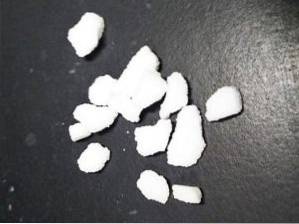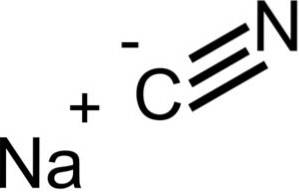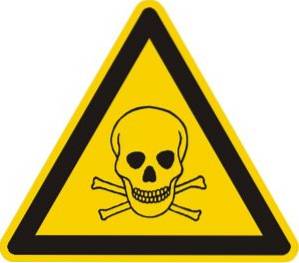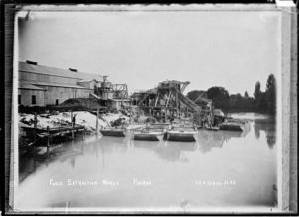
Sodium cyanide (NaCN) structure, properties, risks, uses

The Sodium cyanide is an inorganic salt formed by a sodium cation Na+ and a cyanide anion CN-. Its chemical formula is NaCN. Also known as sodium cyanide, it is a white crystalline solid. It is hygroscopic, that is, it absorbs water from the environment, and its crystals are cubic like sodium chloride NaCl.
When dissolved in water it tends to form hydrogen cyanide HCN. Its solutions dissolve gold and silver easily. This characteristic makes it used to extract gold and silver from its minerals. The solutions used for this purpose are recycled, that is, they are reused several times.

However, some of the cyanide manages to escape into certain waste ponds, which represents a danger to wildlife and to humans, as cyanide is very toxic and can cause death..
NaCN is used in the chemical industry as an intermediate to prepare various types of compounds, such as dyes, agricultural chemicals, and drugs or medicines..
Sodium cyanide is a very dangerous compound as it can cause death, so it must be handled with extreme caution.
Article index
- 1 Structure
- 2 Nomenclature
- 3 Properties
- 3.1 Physical state
- 3.2 Molecular weight
- 3.3 Melting point
- 3.4 Boiling point
- 3.5 Flash point
- 3.6 Density
- 3.7 Solubility
- 3.8 Dissociation constant
- 3.9 pH
- 3.10 Chemical properties
- 4 Risks
- 5 Obtaining
- 6 Uses
- 6.1 In the extraction of gold and silver minerals. Consequences
- 6.2 In the production of other chemical compounds
- 6.3 In the metal industry
- 6.4 In other uses
- 6.5 Out of use, questioned or very rare applications
- 7 References
Structure
Sodium cyanide is made up of a Na + ion and a CN ion-.

The cyanide ion has a carbon atom C and a nitrogen atom N linked to each other by a triple bond..

NaCN has the same crystalline structure as NaCl, so its crystals are cubic.
Nomenclature
-Sodium cyanide
-Sodium cyanide
Properties
Physical state
Hygroscopic white crystalline solid (absorbs water from the environment).
Molecular weight
49.007 g / mol
Melting point
563.7 ºC
Boiling point
1496 ºC
Flashpoint
It is not flammable. But if exposed to a fire, HCN hydrogen cyanide and nitrogen oxides are produced..
Density
1,595 g / cm3 at 20 ºC
Solubility
Very soluble in water: 48 g / 100 mL at 10ºC, 82 g / 100 mL at 35ºC. Slightly soluble in alcohol
Dissociation constant
It is hydrolyzed in aqueous solution generating hydrogen cyanide HCN. The constant of this hydrolysis is Kh = 2.5 x 10-5.
pH
Aqueous NaCN solutions are strongly alkaline
Chemical properties
When dissolved in water, it separates into its Na ions+ and CN-. In aqueous solution the cyanide ion CN- take a proton H+ of water HtwoOr forming HCN and an OH ion-, so the solution becomes alkaline.
CN- + HtwoO → HCN + OH-
For this reason, its aqueous solutions decompose rapidly when stored, forming hydrogen cyanide HCN..
It is corrosive towards aluminum. Its solutions easily dissolve gold Au and silver Ag in the presence of air..
It is a chelating agent since the cyanide anion CN- can easily bind to other metals, such as silver, gold, mercury, zinc, cadmium, etc..
Has a faint bitter almond odor.
Risks
It must be handled with great care. It is a highly poisonous compound, inhibits important metabolic processes, and leads to death by ingestion, inhalation, absorption through the skin or contact with the eyes..
If inhaled, NaCN dissolves in the mucosa of the respiratory tract and passes into the bloodstream. The cyanide ion of NaCN has a strong affinity for iron in the oxidation state of +3, that is, the ferric cation Fe3+.
When cyanide is absorbed, it reacts rapidly with Fe3+ of an important enzyme of the mitochondria of cells (cytochrome oxidase), preventing certain processes of the respiration of this.
Therefore, cellular respiration is inhibited or slowed down and cytotoxic hypoxia results. It means that cells and tissues are unable to use oxygen, especially brain and heart cells.
In this way, permanent or lethal damage to the body occurs. This can occur in both humans and animals..
If ingested, it causes congestion of the blood vessels and corrosion of the gastric mucosa, in addition to the aforementioned.

It is not combustible, but in contact with acids, it releases HCN which is highly flammable and toxic.
If it melts with nitrites or chlorates it can explode.
Obtaining
Can be obtained with sodium Na, ammonia NH3 and carbon C. Sodium reacts with ammonia to give sodium amide NaNHtwo:
2 Na + 2 NH3 → 2 NaNHtwo + Htwo↑
Sodium amide is heated with charcoal to 600 ° C and produces sodium cyanamide NatwoNCN, which is then converted to sodium cyanide with charcoal at 800 ºC:
2 NaNHtwo + C → 2 Htwo↑ + NatwoNCN
NatwoNCN + C → 2 NaCN
Another method is to melt calcium cyanamide CaNCN and carbon C with sodium carbonate NatwoCO3:
CaNCN + C + NatwoCO3 → CaCO3 + 2 NaCN
It can also be prepared by passing nitrogen gas Ntwo by a hot mixture of sodium carbonate NatwoCO3 and powdered carbon C, using iron Fe as catalyst or reaction accelerator:
NatwoCO3 + 4 C + Ntwo → 2 NaCN + 3 CO ↑
Applications
In the extraction of gold and silver minerals. Consequences
Sodium cyanide has long been used to extract the metals gold and silver from their ores..
The cyanide used in the process is recycled, but something escapes into the waste pond along with the unrecovered heavy metals.
Birds, bats and other animals that drink from these cyanide lagoons have been poisoned.
There are records of a dam in Romania that isolated a waste pond and was damaged by a weather event..
As a consequence, tons of cyanide were released into the Sasar River and nearby aquifer systems such as the Lapus, Somes, and Tisza rivers, ending in the Danube..
This caused a cascade of animal deaths, or in other words, an ecological disaster..

In the production of other chemical compounds
NaCN sodium cyanide is used in the synthesis of various types of organic compounds.
For example, pigments and colorants (including optical brighteners), compounds for use in agriculture or agrochemicals and various pharmaceuticals are prepared..
It is also used to obtain chelating or sequestering agents for metal ions..
Compounds called nitriles are prepared with sodium cyanide NaCN, which when treated with a hot acidic or alkaline aqueous solution allows obtaining carboxylic acids.

It allows to prepare fatty acids with cyano groups, heavy metal cyanides and hydrocyanic acid or HCN hydrogen cyanide.
In the metal industry
NaCN is used in solutions used in electroplating or electroplating of metals (coating of metals with others), for example zinc.
It is a component of hardened steel. Also serves in metal cleaning.
In other uses
Sodium cyanide is an intermediate in the manufacture of nylon.
Serves for the separation of minerals by foam flotation.
Applications out of use, questioned or very rare
NaCN was used to kill rodents, such as rabbits and rats, and their burrows, and to kill termite nests.
Currently it is used occasionally to eliminate coyotes, foxes and wild dogs. Used in capsule form as single or multiple doses on rangelands, hunting grounds, and forests.
Due to its extreme toxicity, NaCN should only be used by trained individuals..
This use is considered very dangerous for humans, but there are those who still use it.

In agriculture it was formerly used to fumigate citrus fruit trees and other fruits. It was also used as an insecticide and miticide (mite eliminator) to be applied after harvest, for non-stored citrus fruits or for the fumigation of trucks used to transport them. It was also used to fumigate ships, rail cars, and warehouses..
All of these uses have been questioned due to the high toxicity of sodium cyanide. For this reason, it is no longer used or only very rarely and under very controlled conditions..
References
- U.S. National Library of Medicine. (2019). Sodium cyanide. Recovered from pubchem.ncbi.nlm.nih.gov.
- Kirk-Othmer (1994). Encyclopedia of Chemical Technology. Fourth Edition. John Wiley & Sons.
- Hurst, H.E. and Martin, M.D. (2017). Toxicology. Cyanide. In Pharmacology and Therapeutics for Dentistry (Seventh Edition). Recovered from sciencedirect.com.
- Coppock, R.W. and Dziwenka, M. (2015). Threats to Wildlife by Chemical Warfare Agents. In Handbook of Toxicology of Chemical Warfare Agents (Second Edition). Recovered from sciencedirect.com.
- Morrison, R.T. and Boyd, R.N. (2002). Organic Chemistry. 6th Edition. Prentice-Hall.



Yet No Comments